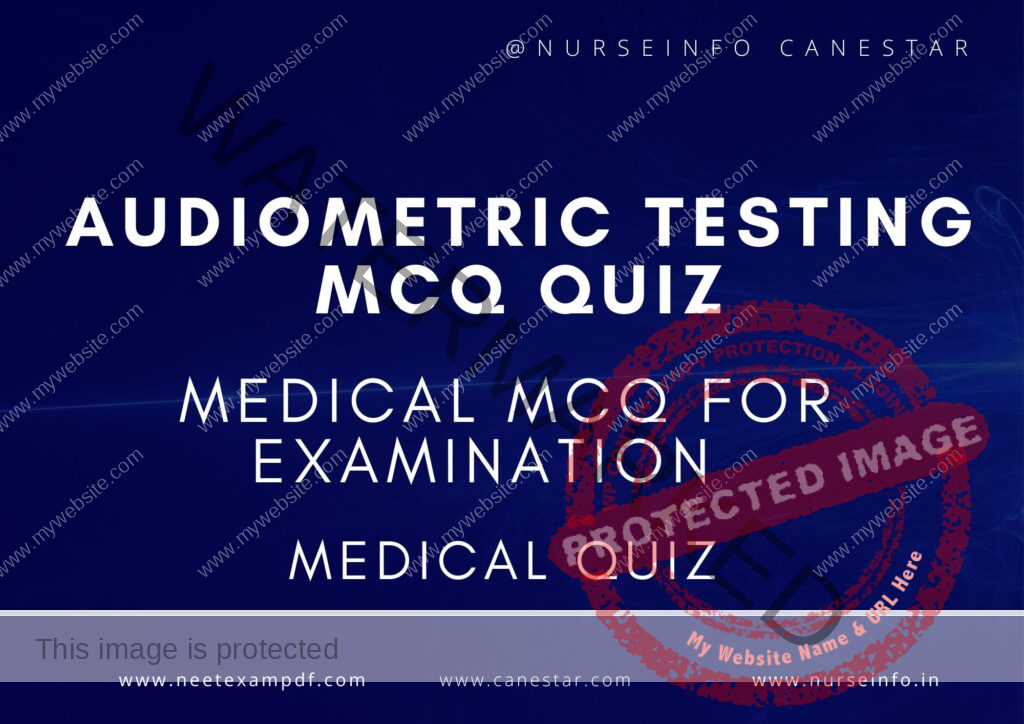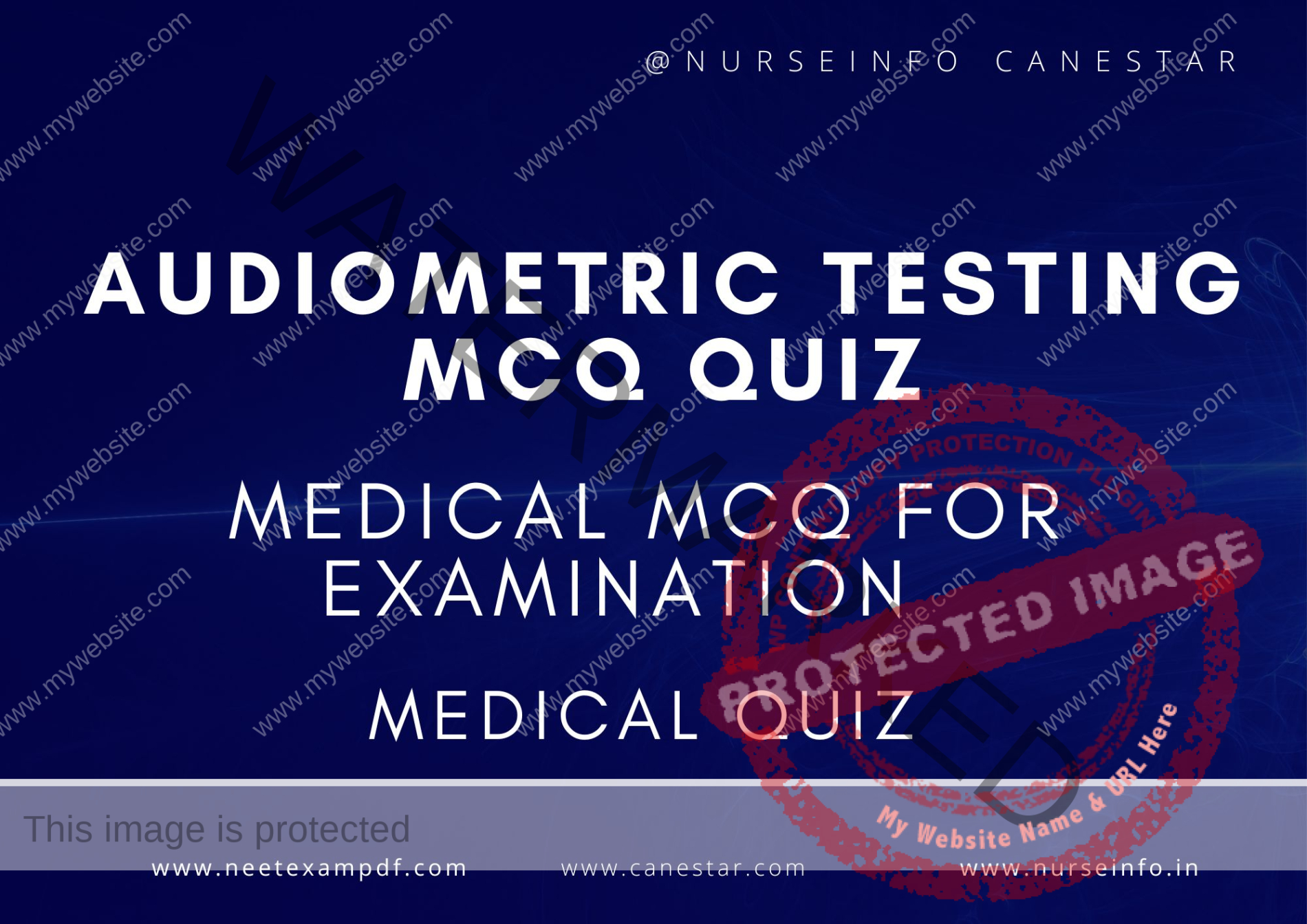MULTIPLE CHOICE QUESTIONS ON AUDIOMETRIC TESTING QUIZ – MCQS WITH RATIONALE ANSWER – AUDIOMETRIC TESTING MCQ QUESTIONS WITH RATIONALE
MCQ FOR AUDIOMETRIC TESTING QUIZ
These mcqs are prepared exclusively for medical professionals for exam preparation. MCQ is helpful to remember the concept on audiometric testing mcq quiz. This multiple choice questions are helpful for preparation for DHA, PROMETRIC, MOH, HAAD, NCLEX, Medical, NEET and Nursing EXAMINATION
AUDIOMETRIC TESTING MCQ QUIZ
Audiometric Testing MCQs with Rationale Answers
What is the primary purpose of pure-tone audiometry?
a) To assess speech discrimination
b) To measure the loudness of sounds
c) To determine hearing thresholds at various frequencies
d) To evaluate the function of the inner ear
Answer: c) To determine hearing thresholds at various frequencies
Rationale: Pure-tone audiometry is used to identify the quietest sounds a person can hear at different frequencies, helping to diagnose hearing loss.
Which type of hearing loss is characterized by air-bone gaps on an audiogram?
a) Sensorineural hearing loss
b) Conductive hearing loss
c) Mixed hearing loss
d) Central hearing loss
Answer: b) Conductive hearing loss
Rationale: Conductive hearing loss is indicated by a gap between air conduction (AC) and bone conduction (BC) thresholds on an audiogram, reflecting problems in the outer or middle ear.
Which part of the auditory system is primarily tested by bone conduction audiometry?
a) Outer ear
b) Middle ear
c) Inner ear
d) Auditory nerve
Answer: c) Inner ear
Rationale: Bone conduction audiometry bypasses the outer and middle ear, directly stimulating the inner ear and auditory nerve, helping to assess sensorineural components of hearing loss.
What is the purpose of masking in audiometric testing?
a) To isolate the test ear by preventing the non-test ear from detecting the test signal
b) To increase the volume of the test signal
c) To evaluate the patient’s speech recognition ability
d) To test the patient’s balance
Answer: a) To isolate the test ear by preventing the non-test ear from detecting the test signal
Rationale: Masking is used to ensure that the non-test ear does not respond to the test signal, providing accurate threshold measurements for the test ear.
What does a type A tympanogram indicate?
a) Normal middle ear function
b) Eustachian tube dysfunction
c) Middle ear fluid
d) Tympanic membrane perforation
Answer: a) Normal middle ear function
Rationale: A type A tympanogram shows a peak at or near atmospheric pressure, indicating normal middle ear pressure and compliance.
Which audiometric test assesses the ability to understand speech in a noisy environment?
a) Pure-tone audiometry
b) Tympanometry
c) Speech recognition threshold (SRT)
d) Speech-in-noise test
Answer: d) Speech-in-noise test
Rationale: The speech-in-noise test evaluates how well a person can understand speech against background noise, which is important for diagnosing issues related to auditory processing.
Which term describes the lowest intensity level at which a patient can correctly repeat 50% of the words presented?
a) Pure-tone average (PTA)
b) Speech reception threshold (SRT)
c) Word recognition score (WRS)
d) Most comfortable loudness level (MCL)
Answer: b) Speech reception threshold (SRT)
Rationale: The SRT is the lowest intensity at which 50% of speech material is correctly identified, reflecting the person’s ability to detect and recognize speech sounds.
What is the significance of the word recognition score (WRS) in audiometric testing?
a) To determine the quietest sound a person can hear
b) To evaluate middle ear function
c) To measure the percentage of words correctly repeated at a comfortable listening level
d) To assess balance function
Answer: c) To measure the percentage of words correctly repeated at a comfortable listening level
Rationale: The WRS evaluates the clarity of speech understanding at a comfortable listening level, providing insight into the functional impact of hearing loss.
In an audiogram, what does a downward sloping pattern typically indicate?
a) Low-frequency hearing loss
b) High-frequency hearing loss
c) Flat hearing loss
d) Normal hearing
Answer: b) High-frequency hearing loss
Rationale: A downward sloping audiogram indicates better hearing at lower frequencies and poorer hearing at higher frequencies, often seen in sensorineural hearing loss due to aging or noise exposure.
What does the abbreviation “dB HL” stand for in audiometric testing?
a) Decibels hearing level
b) Decibels loudness level
c) Decibels high level
d) Decibels harmonic level
Answer: a) Decibels hearing level
Rationale: dB HL refers to decibels hearing level, a unit of measurement used to quantify hearing thresholds relative to a standardized normal hearing level.
Which type of otoacoustic emissions (OAEs) is commonly used in newborn hearing screenings?
a) Spontaneous OAEs
b) Transient-evoked OAEs (TEOAEs)
c) Distortion-product OAEs (DPOAEs)
d) Click-evoked OAEs
Answer: b) Transient-evoked OAEs (TEOAEs)
Rationale: TEOAEs are often used in newborn hearing screenings because they are sensitive to cochlear function and can detect hearing loss at an early stage.
Which auditory evoked potential is used to assess the integrity of the auditory pathway up to the brainstem?
a) Auditory brainstem response (ABR)
b) Electrocochleography (ECoG)
c) Middle latency response (MLR)
d) Cortical auditory evoked potential (CAEP)
Answer: a) Auditory brainstem response (ABR)
Rationale: ABR tests the auditory pathway from the cochlea to the brainstem, helping to diagnose neural hearing loss and other auditory pathway disorders.
What is the purpose of the pure-tone average (PTA) in audiometric testing?
a) To measure word recognition ability
b) To assess middle ear pressure
c) To calculate the average hearing threshold at 500, 1000, and 2000 Hz
d) To evaluate balance function
Answer: c) To calculate the average hearing threshold at 500, 1000, and 2000 Hz
Rationale: The PTA provides a summary of hearing sensitivity by averaging thresholds at key frequencies, often used to describe the degree of hearing loss.
Which hearing test is performed using a bone vibrator placed on the mastoid bone?
a) Air conduction audiometry
b) Bone conduction audiometry
c) Speech audiometry
d) Tympanometry
Answer: b) Bone conduction audiometry
Rationale: Bone conduction audiometry uses a bone vibrator to directly stimulate the cochlea, bypassing the outer and middle ear to assess inner ear and auditory nerve function.
What is a key characteristic of sensorineural hearing loss on an audiogram?
a) Presence of air-bone gaps
b) Equal air and bone conduction thresholds
c) Normal hearing thresholds
d) Fluctuating hearing thresholds
Answer: b) Equal air and bone conduction thresholds
Rationale: Sensorineural hearing loss typically shows similar air and bone conduction thresholds because the loss is due to inner ear or auditory nerve dysfunction.
Which audiometric test is used to assess the stiffness of the middle ear system?
a) Tympanometry
b) Pure-tone audiometry
c) Speech audiometry
d) Otoacoustic emissions
Answer: a) Tympanometry
Rationale: Tympanometry measures middle ear mobility and pressure, helping to diagnose conditions like otitis media, eustachian tube dysfunction, and ossicular chain issues.
What does the term “otosclerosis” refer to in the context of audiometric testing?
a) Inflammation of the ear canal
b) Fluid in the middle ear
c) Abnormal bone growth in the middle ear
d) Ruptured eardrum
Answer: c) Abnormal bone growth in the middle ear
Rationale: Otosclerosis is a condition characterized by abnormal bone growth around the stapes bone in the middle ear, leading to conductive hearing loss.
Which type of hearing loss can be caused by prolonged exposure to loud noises?
a) Conductive hearing loss
b) Sensorineural hearing loss
c) Central hearing loss
d) Mixed hearing loss
Answer: b) Sensorineural hearing loss
Rationale: Prolonged exposure to loud noises can damage the hair cells in the cochlea, leading to sensorineural hearing loss, which is often irreversible.


